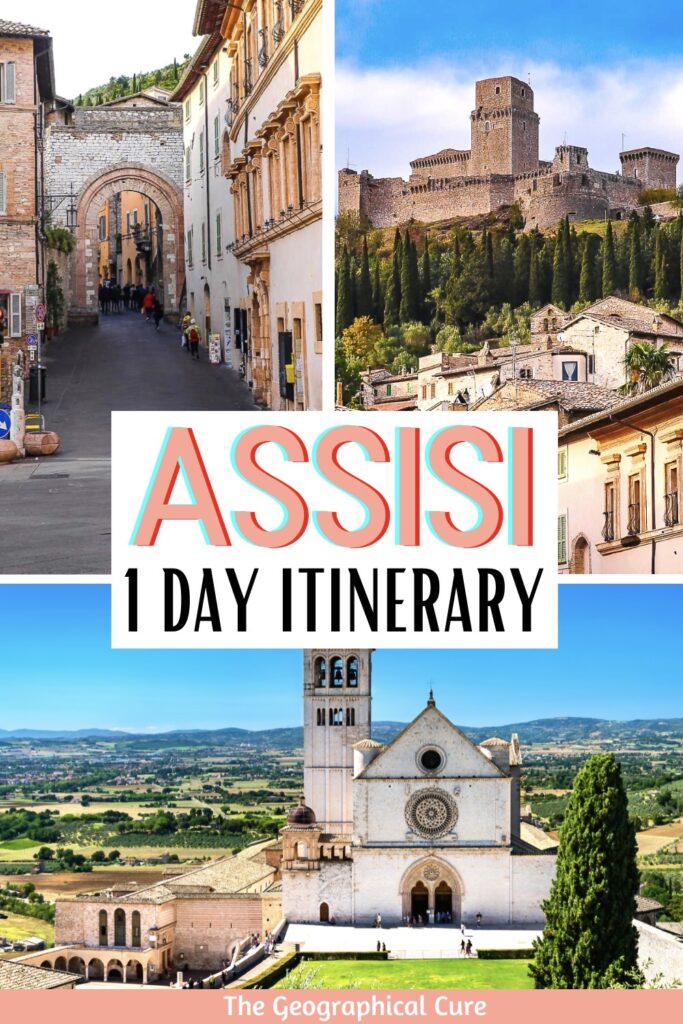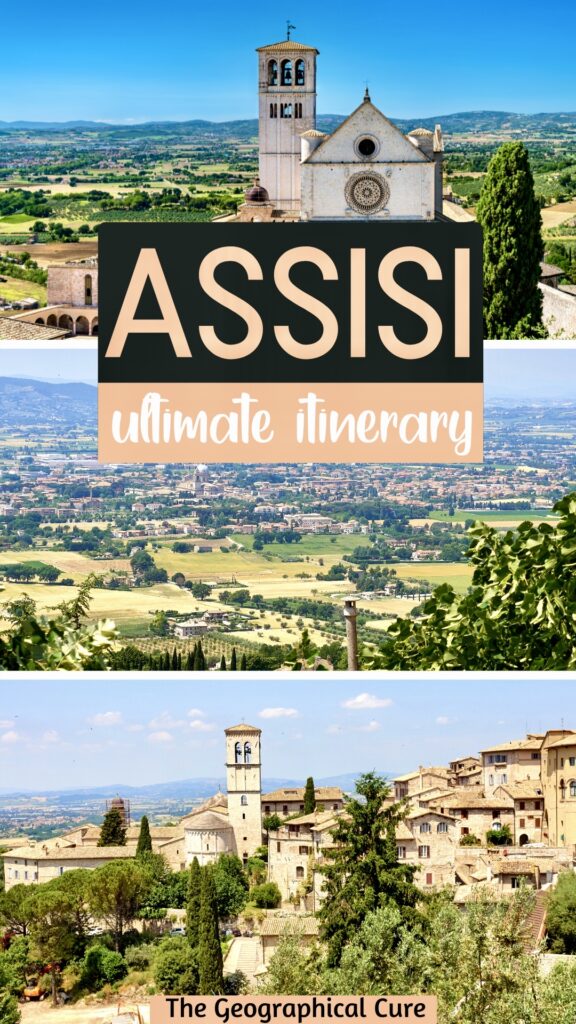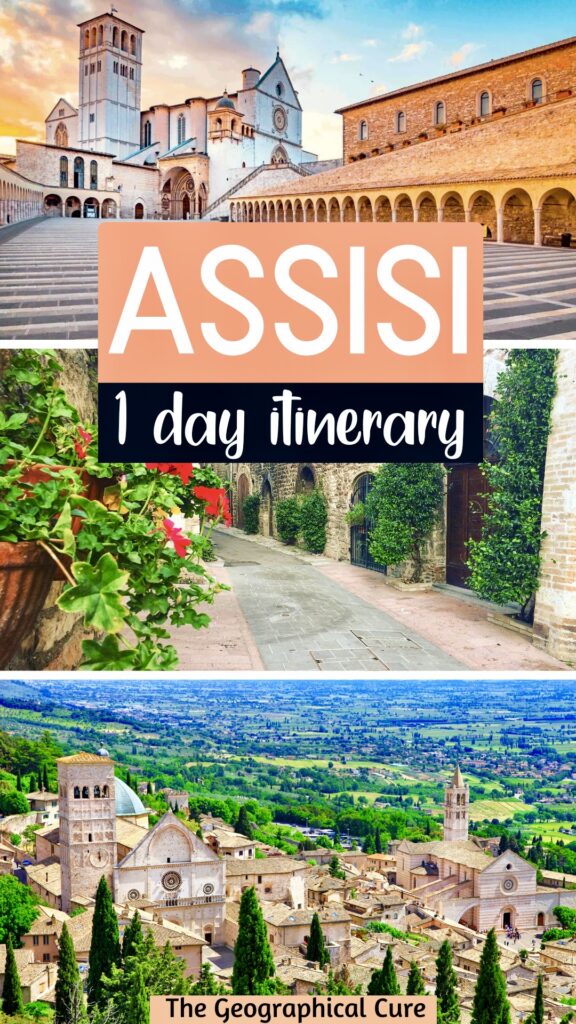Assisi is a charming town nestled atop Mount Subasio in the Italy’s Umbria region. It’s a UNESCO World Heritage site and a must visit for anyone touring Italy. In this one day in Assisi itinerary, I cover the town’s must see attractions and the best things to do to make the most of your visit.
Despite its small size, Assisi packs a punch when it comes to culture. The town boasts Roman ruins, a medley of frescoed churches, charming sun-bleached piazzas, and a rugged fortress with sweeping views.
Assisi is renowned for being the birthplace of Saint Francis, the medieval monk who’s revered as Italy’s most beloved penitent saint. Francis’ legacy lives on in the town, and visitors can explore his story and teachings.
Overview Of One Day in Assisi Itinerary
Here’s a snapshot glance of what you can see with one day in Assisi:
- Basilica of St. Francis
- Piazza della Commune
- Temple of Minerva
- Roman Forum
- Archaeological Museum
- Duomo
- Basilica of St. Clare
- Rocca Maggiore
If you’re in a hurry, below are some of the top tours and experiences for Assisi. Don’t forget to plan ahead when visiting!
- guided tour of the Basilica of St. Francis
- footsteps of St. Francis tour
- market tour & cooking class
- truffle hunting experience
- food and wine tour
- olive oil tasting
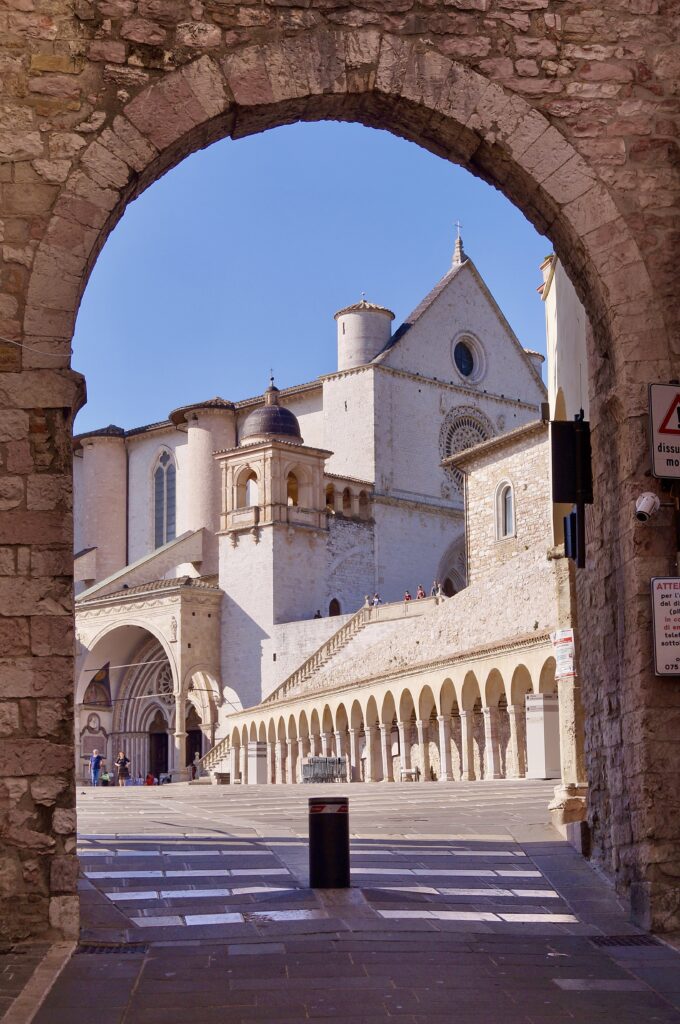
One Day In Assisi Itinerary
Here is my suggested one-day Assisi itinerary that covers the most significant attractions in Assisi.
Basilica of St. Francis of Assisi
The Basilica of St. Francis of Assisi is one of the most important pilgrimage sites in Italy and a UNESCO World Heritage Site. The church is known for its beautiful frescoes by Giotto and other Renaissance artists.
Construction of the basilica began just days after Francis’ death in 1228. The greatest artists of the Early Renaissance converged on the basilica to decorate it. They created a new style of Italian art that would blossom decades later in Florence.
The basilica is divided into two levels: the lower church for pilgrims and the upper church for clergy.
In the lower church, completed in 1230, hidden lights do a masterful job of highlighting the blue starry ceiling and early Renaissance frescoes by Simone Martini, Cimabue, Pietro Lorenzetti, and (possibly) the great Giotto.
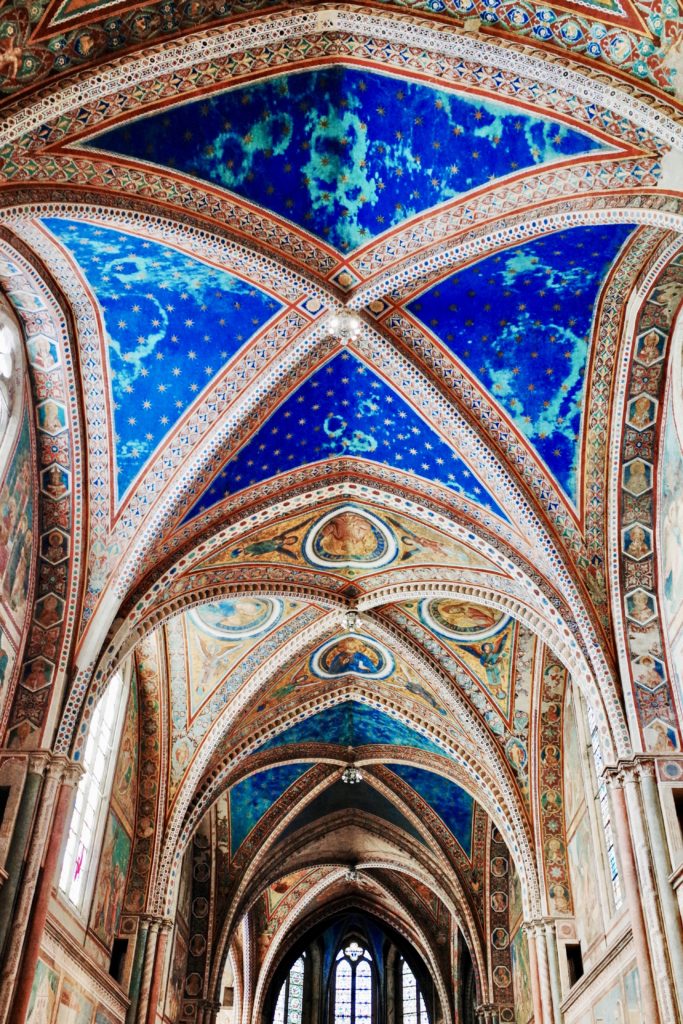
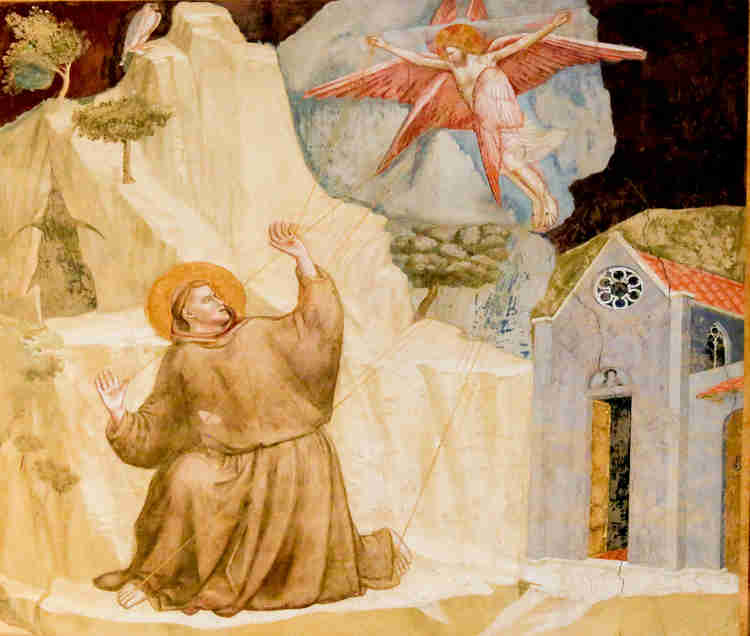
A stairway takes you from the lower basilica to the upper basilica. Built in the elegant French-Gothic style, it features stunning 13th century stained glass windows, the oldest in Italy.
The center aisle contains a famous fresco cycle attributed to Giotto and his school. It depicts scenes from the life of St. Francis The transept and the apse contain rare frescoes by Cimabue.
The basilica is also home to the tomb of Saint Francis, located halfway down the nave. Staircases on both sides lead to the crypt. There’s no coffin or sarcophagus. instead, his remains are inside a (heavily protected) stone pillar that you can walk around and touch.
There’s not much signage inside. So, you may want to book a small group tour or a private tour. They cover the basilica and highlights of the town.
There is no fee to enter the basilica. During high season, it’s open from 6:15 am to 7:30 pm.
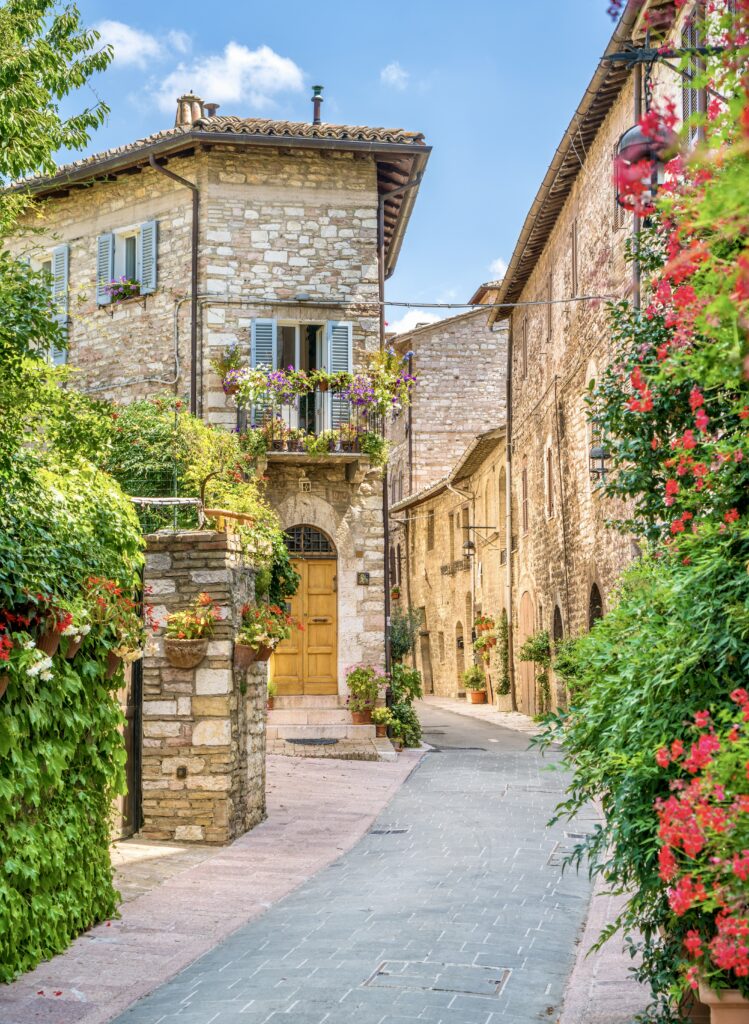
Historic Old Town
Once you’ve visited the basilica, take a stroll through Assisi’s charming medieval streets. The main street, Via San Francesco, is full of local shops and cafes selling souvenirs and products unique to the area.
One shop worth checking out is Handmade Pottery Derutart, which offers beautiful ceramics featuring classic Deruta designs. You can even get a custom piece made with your name on it!
As you wander through the streets, you’ll eventually come across Piazza del Comune, Assisi’s main square. This bustling hub is home to some of the city’s top attractions, including the Temple of Minerva, Roman Forum ruins, and Palazzo del Capitano del Popolo, which boasts the 155 foot Torre de Popolo.
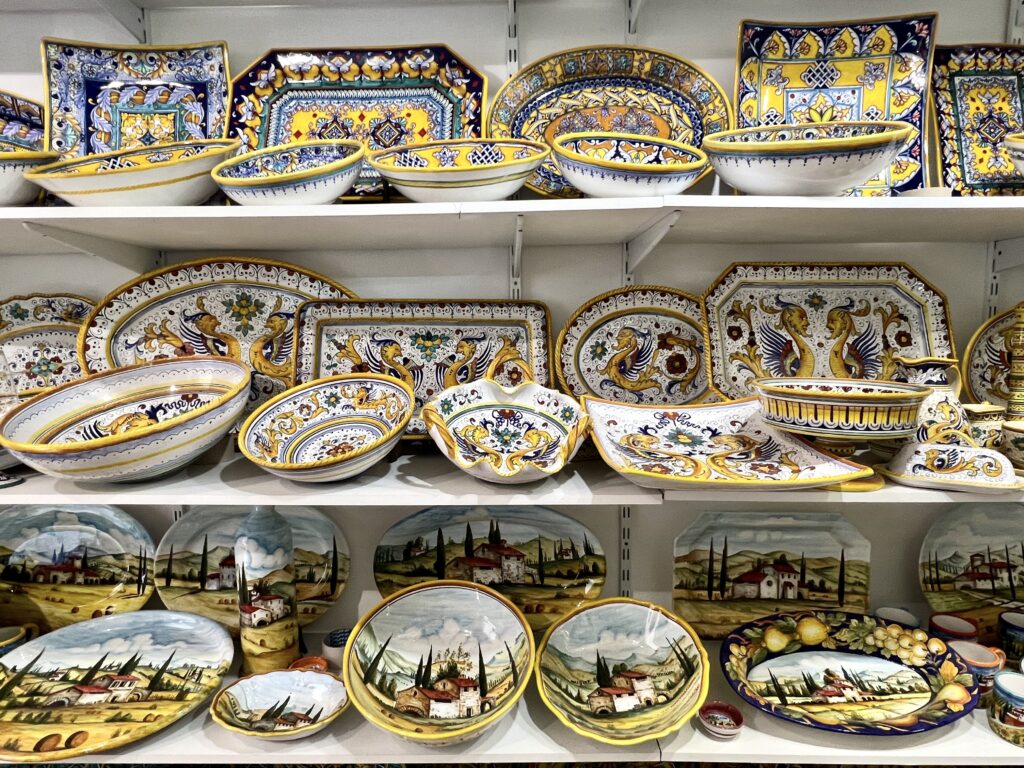
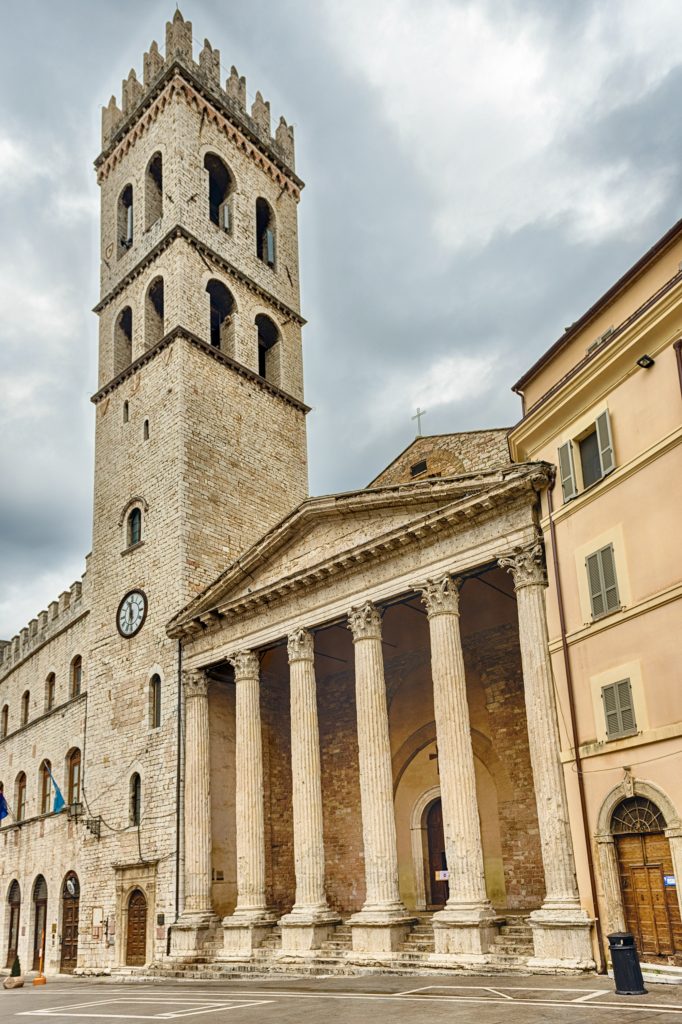
The 13th century tower is currently undergoing renovation, so it can’t be climbed at the moment.
Roman Temple of Minerva
But you can, and should, visit the Temple of Minerva. It’s a well-preserved ancient Roman temple that dates back to the 1st century BC.
The temple was once the centerpiece of Assisi and dominated its Roman Forum. It features six massive Corinthian columns at the front, which rest directly on the steps. The architrave, or main beam across the columns, once held a bronze inscription of the names of the supreme Roman magistrates.
Despite the interior structure being demolished in the 16th century to make way for the Church of San Nicolo, the facade of the ancient temple is preserved.
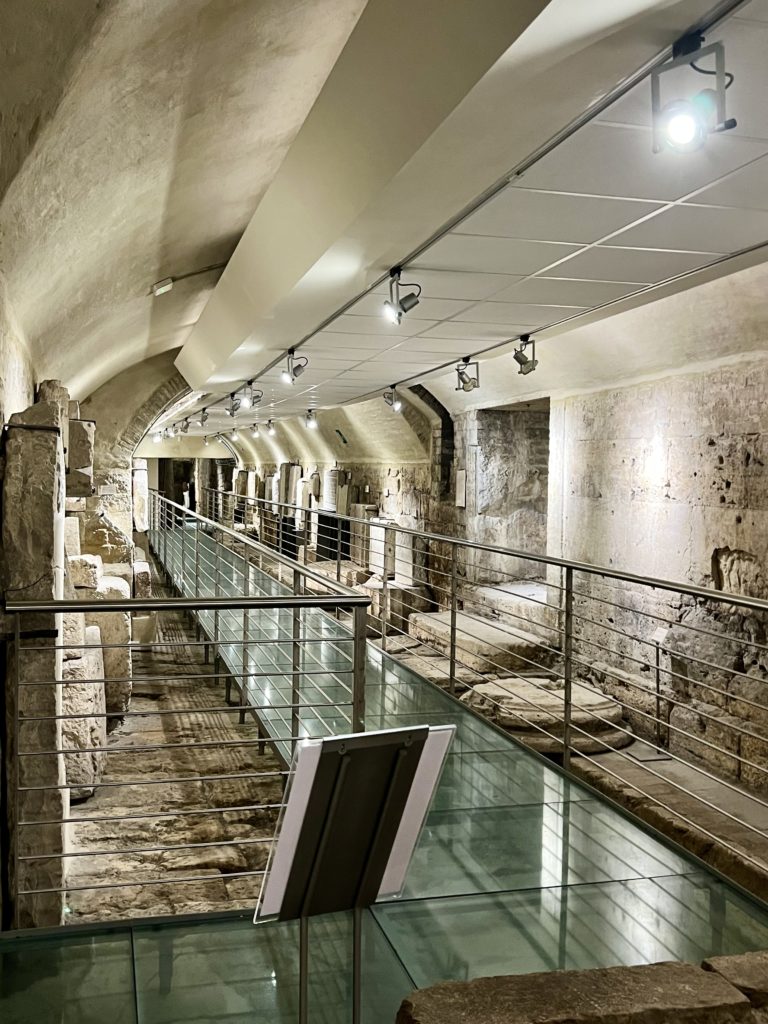
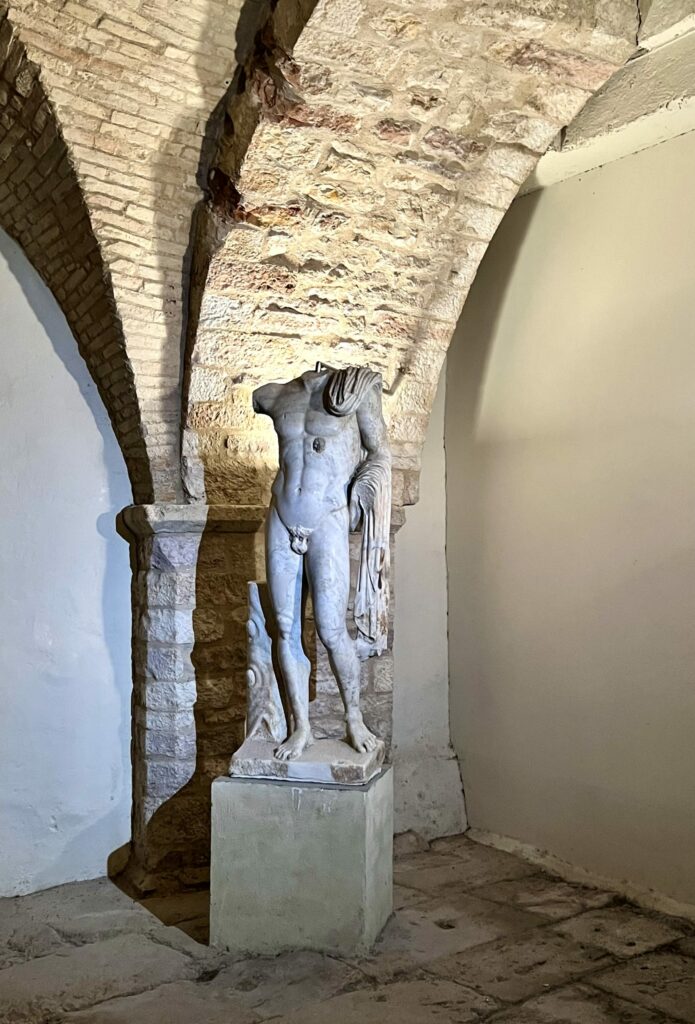
Roman Forum & Archaeological Museum
The Roman Forum and Archaeological Museum in Assisi are located next to the Temple of Minerva. For history buffs, this is a must visit on a one day in Assisi itinerary.
In 1836, the forum was discovered beneath the Piazza del Commune. It once served as the social, economic, and political hub of ancient Asisium.
Today, visitors can see archaeological artifacts from the forum on display in the Archaeological Museum, also known as “Assisi Underground.” On display are inscriptions, funerary steles and urns, fresco fragments, and several large Roman statues dating back to the 1st century.
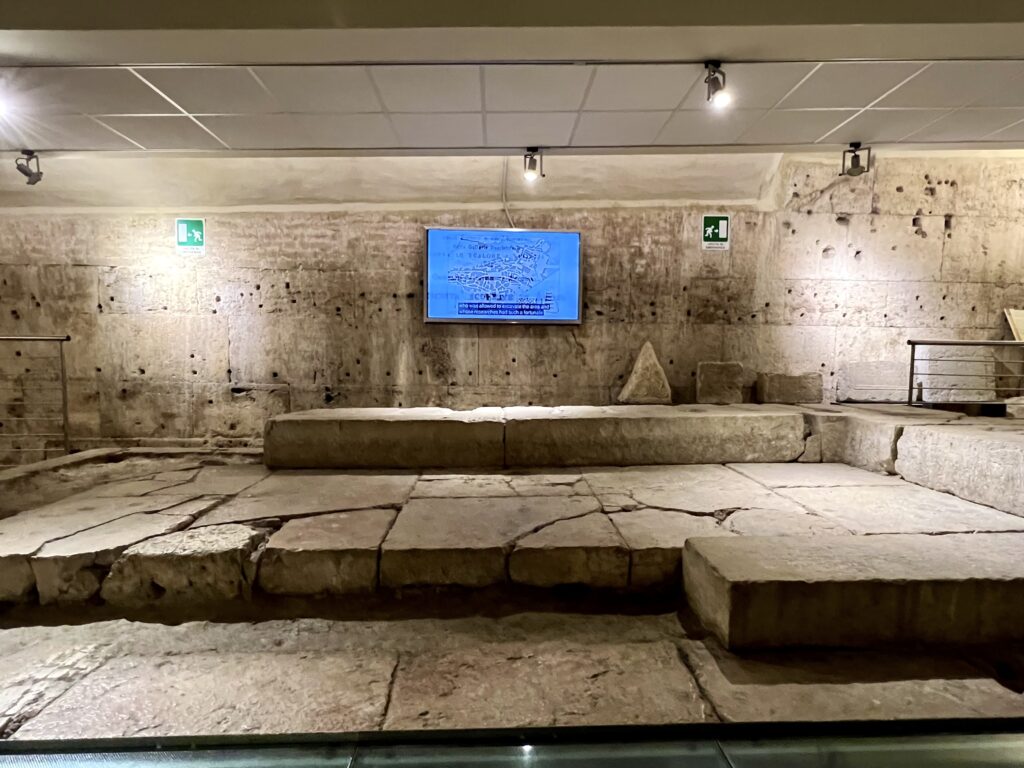
After exploring the museum, visitors can enter a long tunnel to view the ruins of the ancient forum. Walking on glass walkways, you can actually see the ruins beneath your feet.
On the north side of the travertine walls, there are cisterns at each end, with two symmetrical stairways leading up to the temple.
The eastern side of the forum has a row of taberna, or large covered halls. You can also see a series of Doric columns from a portico that once surrounded the forum on three sides.
In the central part of the forum, you can see the remains of a tribunal and podium. This was where speeches were given and justice was meted out, while magistrates looked on from their surrounding seats.
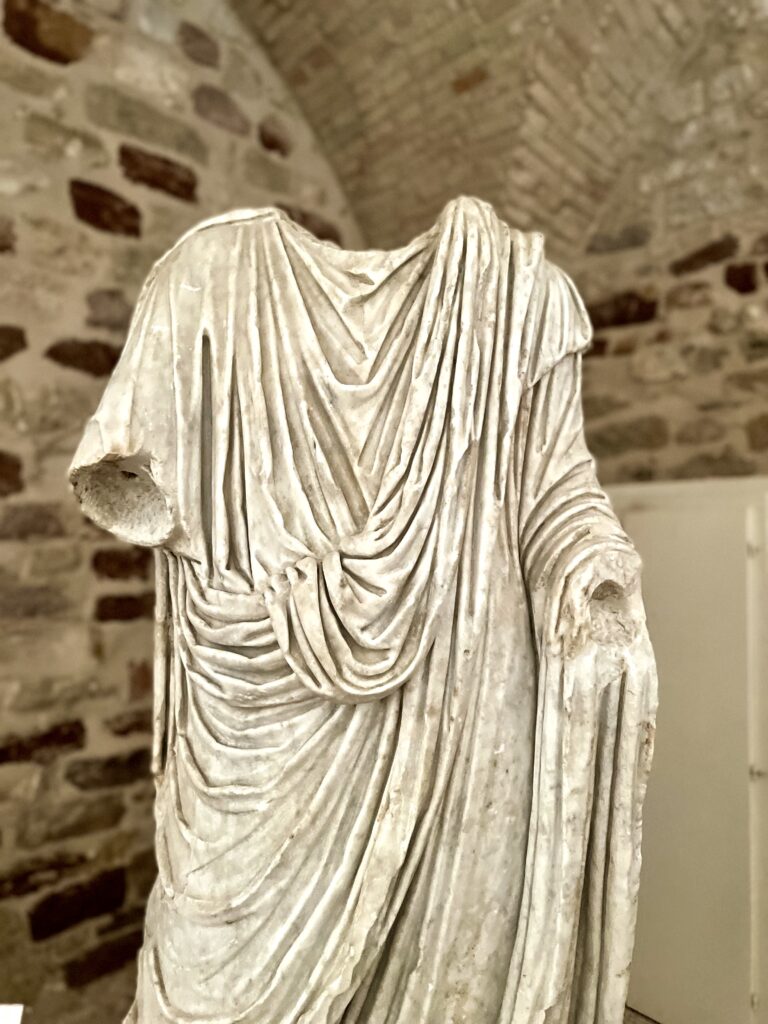
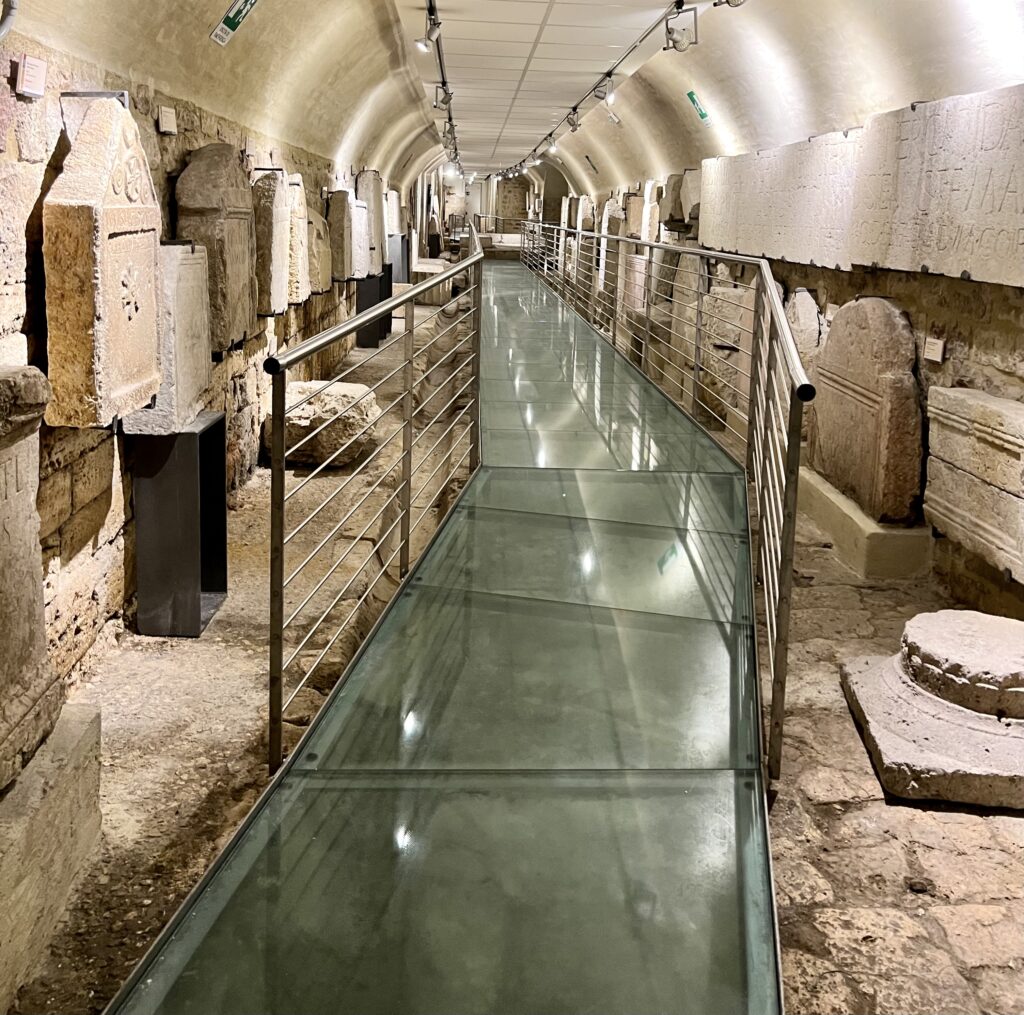
Other ruins include a monumental cistern, a small temple dedicated to Castor and Pollux, a monumental fountain, and remains of a few shops.
This underground space is also nice and cool, making it a great escape from the hot Umbrian sun. Additionally, the space is well signposted in English for easy navigation.
Tickets are 5 euros. It’s open from 10:00 am to 5:30 pm.
Pinacoteca Comunale
If you are an art lover, you may want to visit the Pinacoteca Comunale di Assisi. It’s located in the Baroque era Palazzo Vallemani on Via San Francesca. The pinacoteca is mostly a museum of religious art.
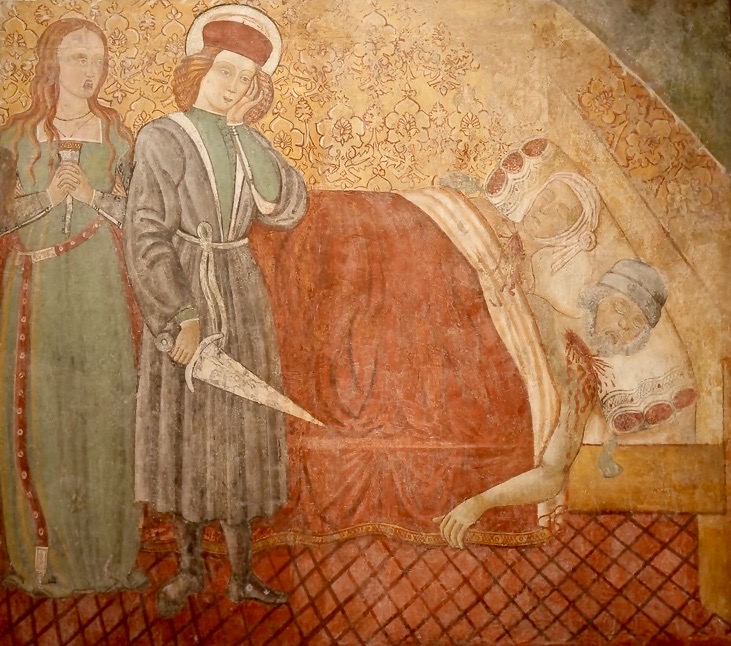
It features a wide variety of Medieval and Renaissance artworks, including paintings by such renowned artists as Perugino and Pinturrichio.
Click here to book a ticket. You can also book a combined ticket for the pinacoteca, Roman Forum, and Rocca Maggiore.
Lunch
There are several places near the Roman Forum where you can grab lunch. Ristorante degli Orti has an outdoor terrace where you can sample modern Italian cuisine.
You can also just grab a panini at a shop along Via San Francesco. Or get some pizza at La Piazetta delle erbe.
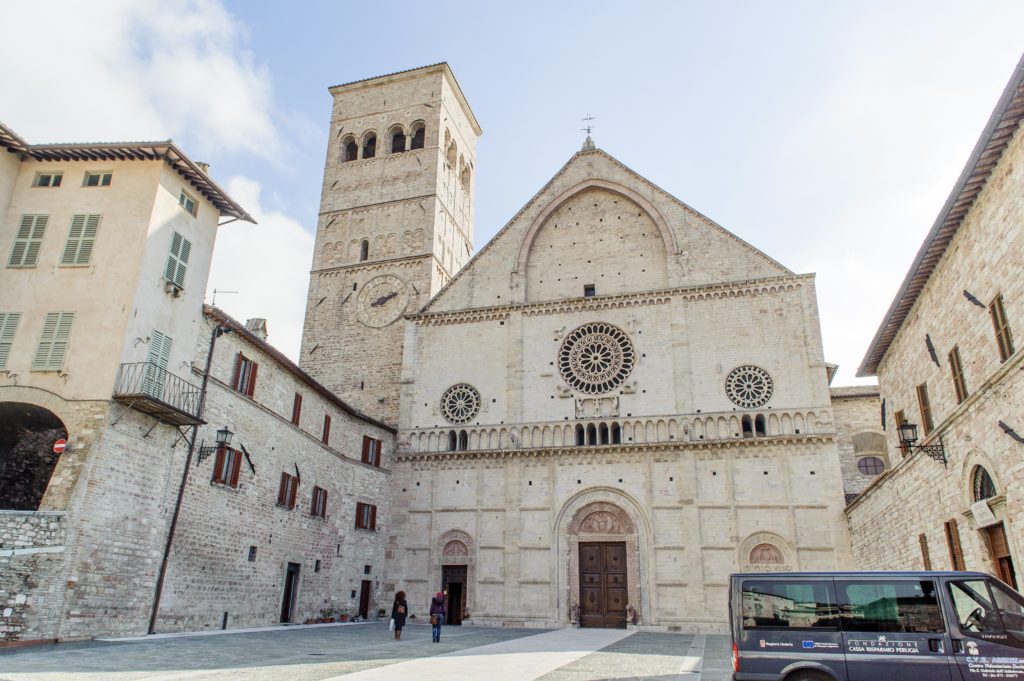
Duomo
After lunch, head to the Cathedral of San Rufino, also known as Assisi’s Duomo. This where both St. Francis and St. Clare were baptized, and you can even see the baptismal font itself.
The church was rebuilt several times since the 11th century. Its facade and rose windows are masterpieces of the Umbrian Romanesque style. The interior, however, is all Renaissance with some lovely frescos.
Inside the cathedral, you can visit a museum, a crypt, and climb the campanile, or bell tower, all of which are well-organized and easily accessible.

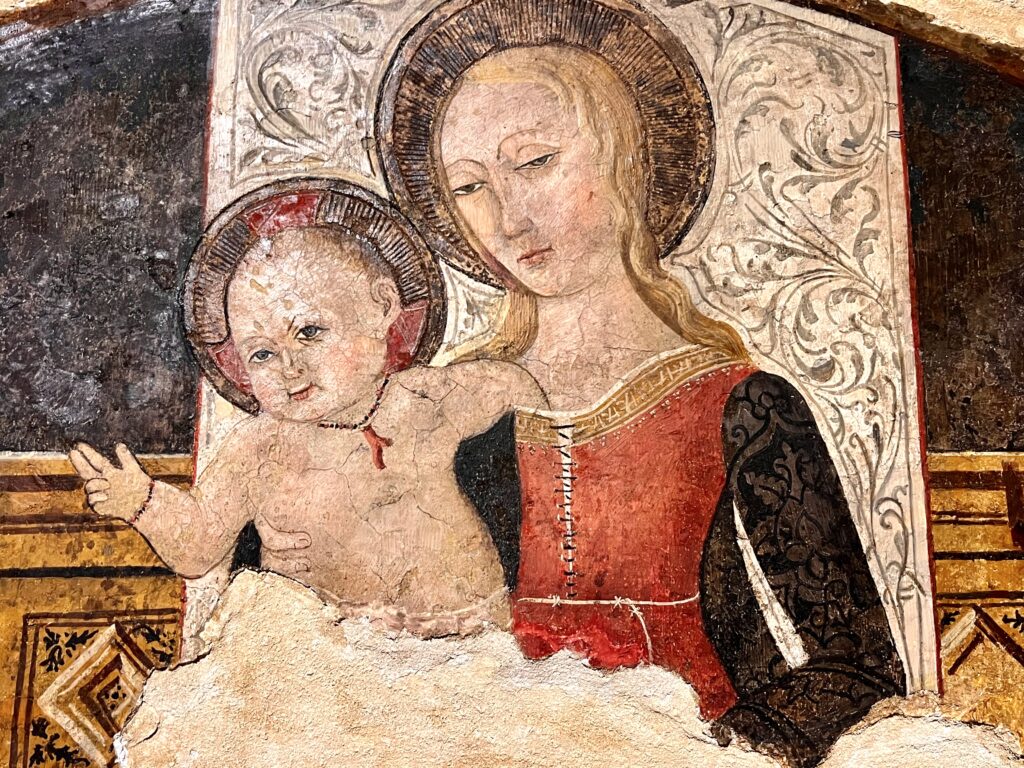
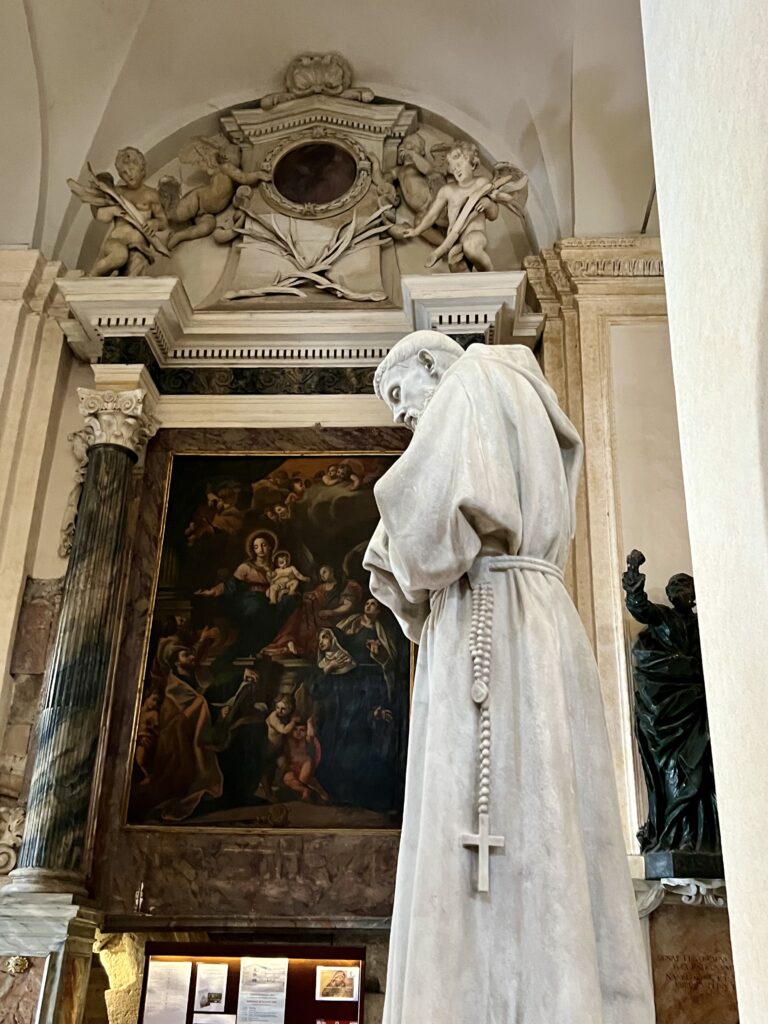
The crypt is a vaulted space, which you can explore on a guided tour.
It contains ancient Roman structures, including part of a Roman house and a Roman cistern. The walls are decorated with frescoes, including scenes from the life of St. Rufinus and St. Francis
I recommend climbing the bell tower first before exploring the rest of the church.
The climb begins with a modern stairway, but the steps become somewhat uneven as you ascend. However, there are good handrails throughout, and a few landings where you can rest.
The climb is quite steep at the very end. But there are spectacular views from the tower. Unfortunately, there’s a metal screen, which gets in the way of getting good photos.
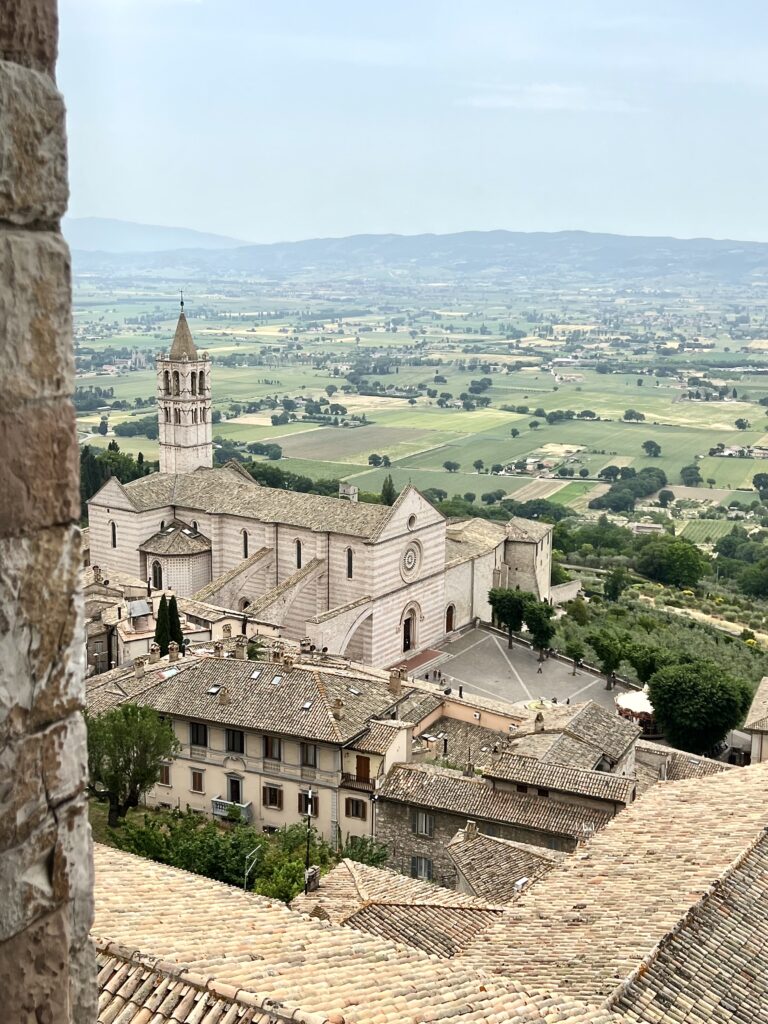
Basilica of St. Clare
Next up on you one day in Assisi itinerary, visit the Basilica di Santa Chiara. The church is dedicated to St. Clare, the founder of the Poor Clares order. Construction of the basilica began in 1255, just one year after Clare was canonized by Pope Pius II.
It was built in the Gothic style over a pre-existing church. The rather muscular rampant arches on the side were added in the 14th century.
The church is made of pretty pink and ivory marble, and the interior is dark and decorated with Giotto-esque frescos.
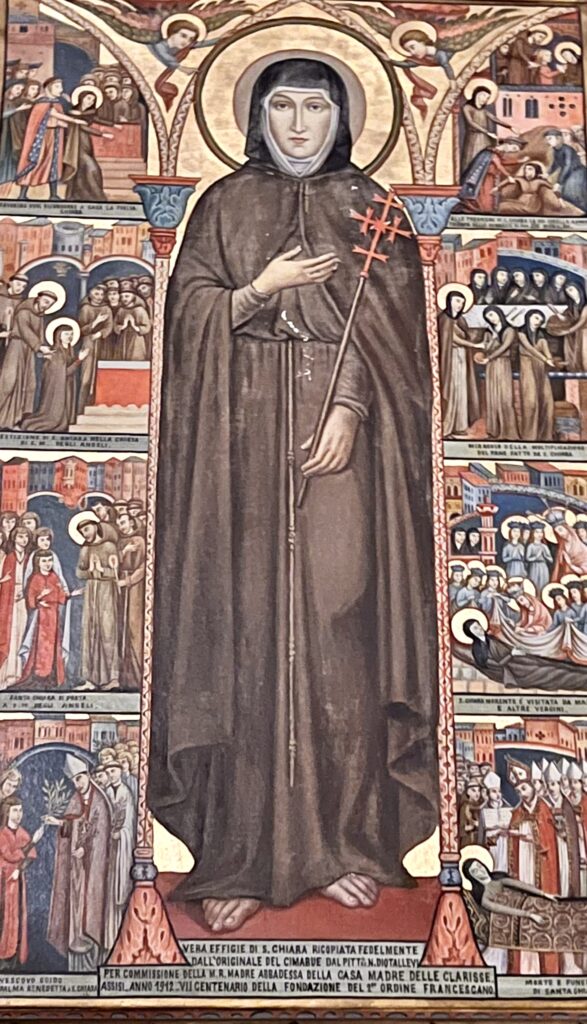
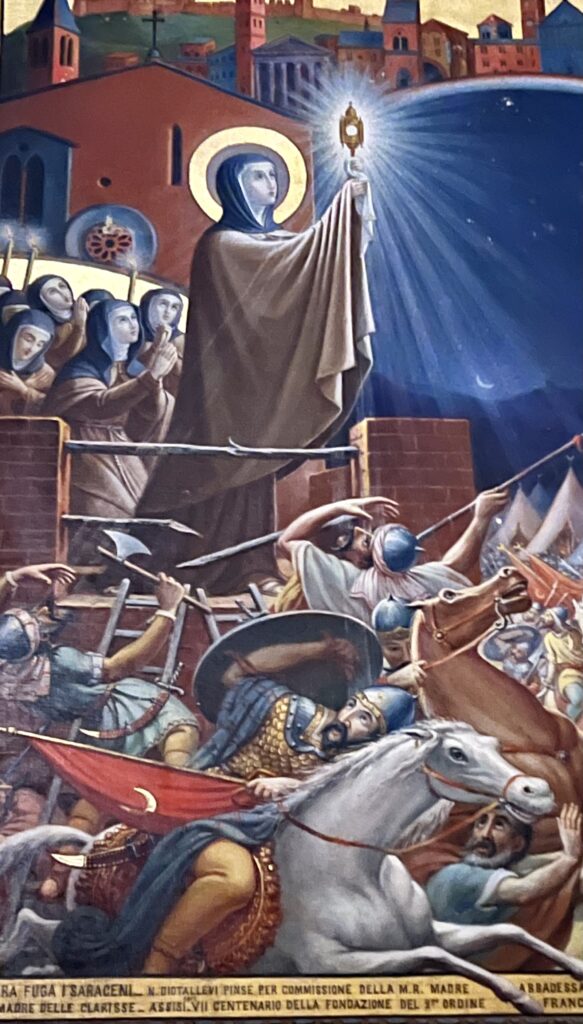
In 1260, Clare’s remains were transferred to the basilica from the Church of St. George in Assisi. Her bones are now located in the basilica crypt, which is built with beautiful pink and green marble.
Clare is buried alongside the Byzantine cross of San Damiano, which Francis prayed to before receiving his mission from God. Additionally, Clare’s sister Agnes is buried in a chapel in the left nave.
If you’re planning a visit to the basilica, be aware that it is closed from noon until 2:00 pm. Before moving on, walk to the edge of Piazza Santa Chiara for a view of the countryside.
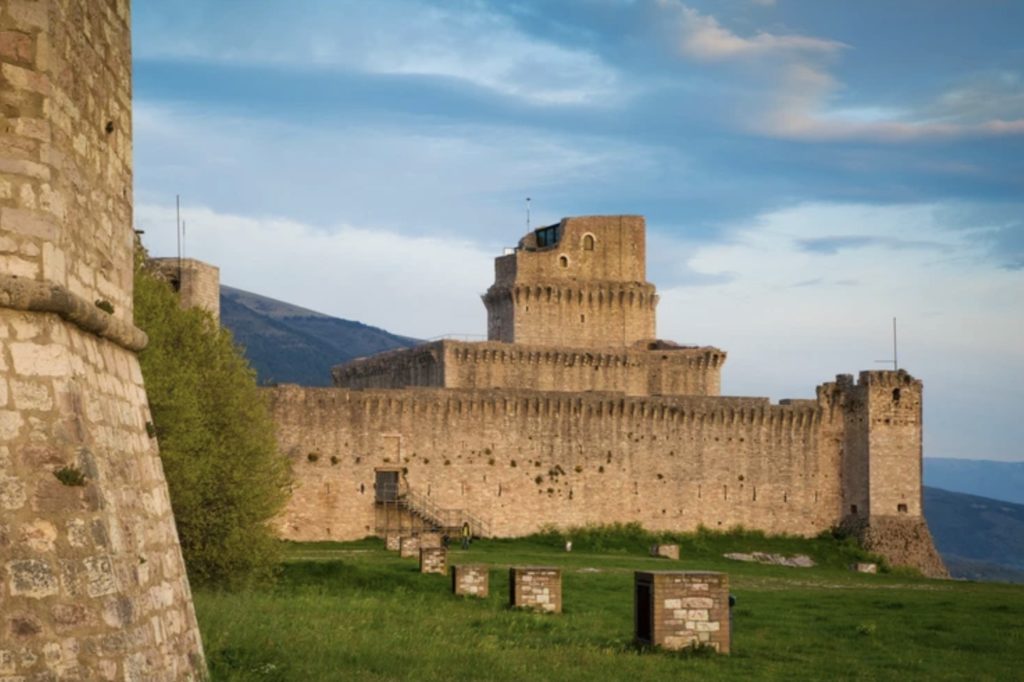
Rocca Maggiore
Polish off your one day in Assisi with a visit to the Rocca Maggiore in the late afternoon. It’s a fearsome fortress that dates back to the 13th century.
Charlemagne built it after conquering Assisi. Over time, the fortress was expanded and modified until the 16th century.
This rugged castle is full of surprises, including tunnels, hidden corners, and even a slightly cramped turret to climb. The fortress has played many roles in its history, serving as a residence, a prison, and a warehouse.
Reaching the Rocca requires a steep hike, but the effort is worth it for the stunning views of Assisi, its grand churches, and the Spoleto valley.
The fortress closes at 4:00 pm. So, be sure to start your hike well before closing time so to allow time to explore the impressive fortress.
But even if you arrive later, you can enjoy the views. From one viewpoint, you can see the town itself. From another, you can see the Basilica of St. Francis.
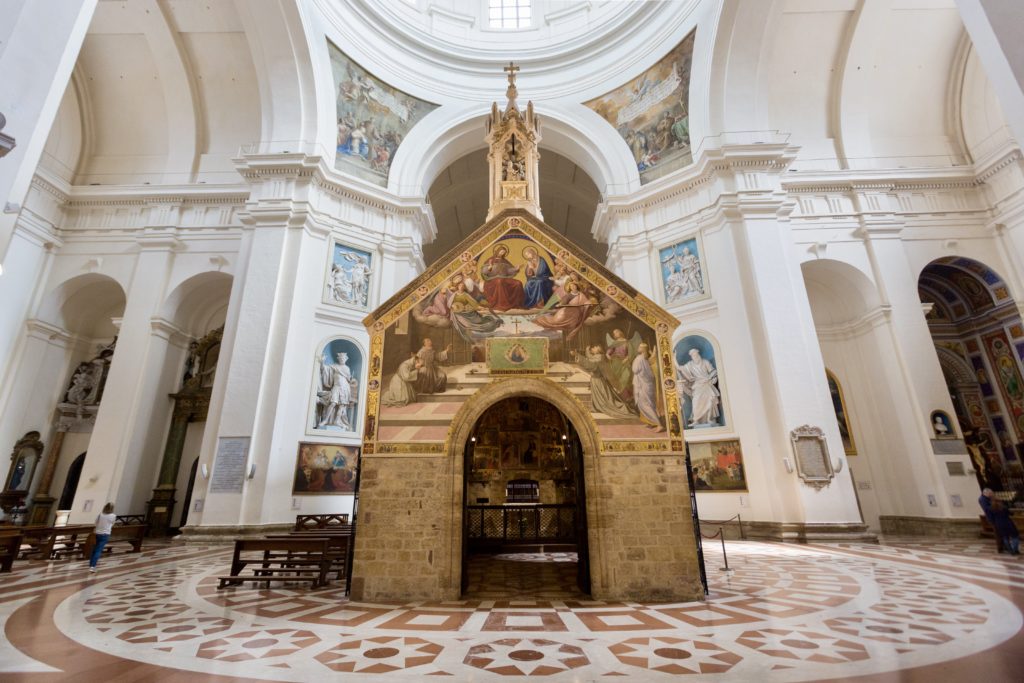
Porziuncola
Alternatively, continuing with the St. Francis theme, you could visit the Basilica of Santa Maria degli Angeli just outside Assisi. It houses the Porziuncola, a humble chapel that was the very place where the Franciscan religion was founded.
Its name, meaning “small portion of land,” speaks to its modest size. The exterior of the stone chapel is adorned with frescoes painted by renowned artists such as Perugino. The interior of the chapel is also decorated with frescoes depicting scenes from the life of St. Francis.
Located behind the Porziuncola is the Chapel of the Transit, which is believed to be the cell where St. Francis drew his last breath. Within the chapel, you can find a statue of the saint standing on the very spot where he famously preached to a flock of doves.
You can reach the basilica by car or via a brief stroll from the train station.
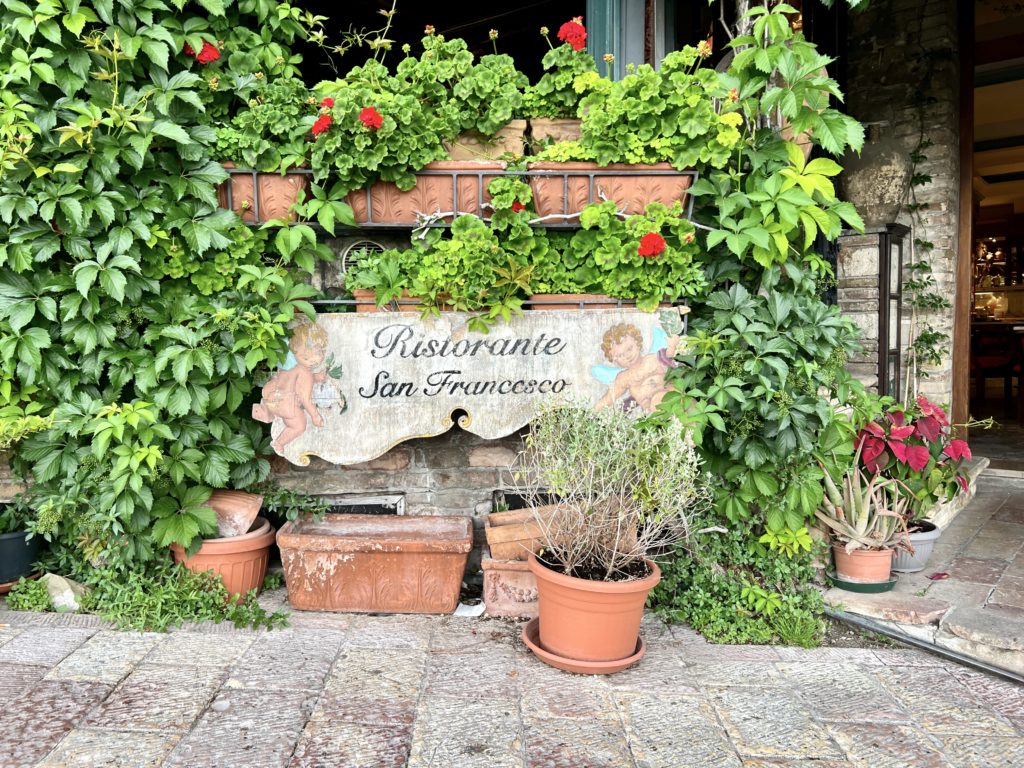
Assisi is especially charming in the evening when the crowds have thinned out, and the town is illuminated with beautiful lighting. Take a leisurely stroll through the quiet streets and explore the town’s hidden corners.
To make the most of your experience, consider joining a guided walking tour offered by several tour operators. These tours provide a unique perspective of the town when it’s quieter and more peaceful.
While you’re out and about, make sure to stop by a wine bar and sample the local tipple. Enoteca Properzio and La Bottega del Buon Caffè are two popular wine bars where you can taste some of the best wines in the region.
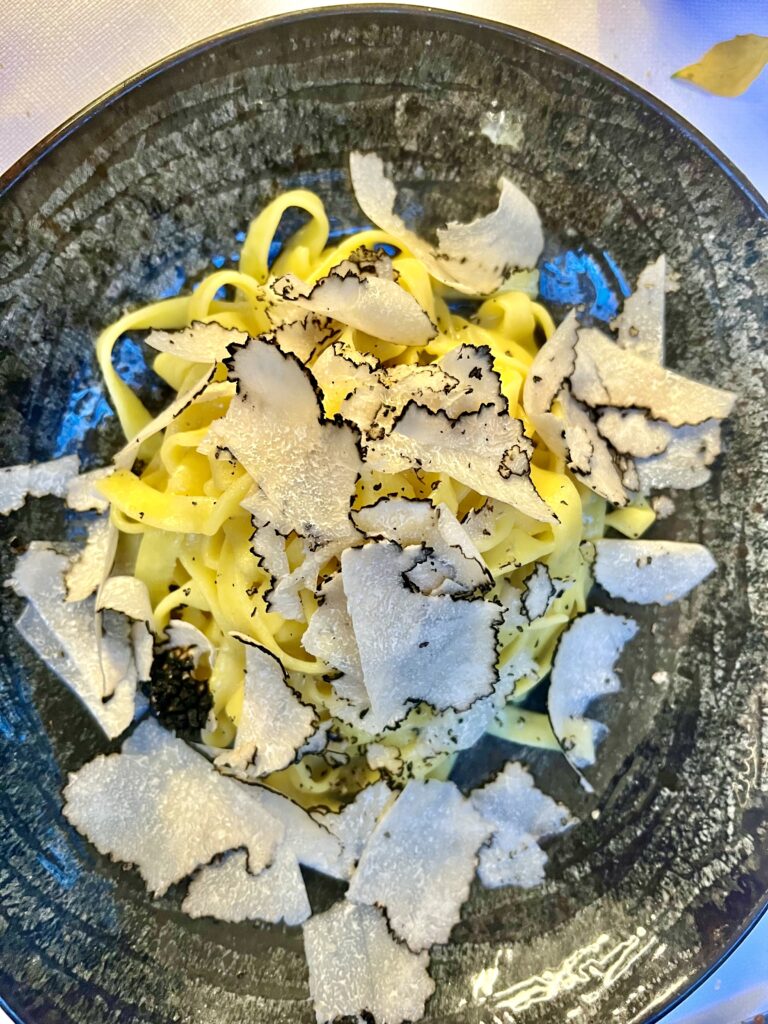
And of course, no trip to Assisi would be complete without indulging in some traditional Umbrian cuisine. There are many excellent restaurants in town where you can savor local specialties like truffle pasta, roasted meat, or cheeses and wines produced in the region.
Il Vicoletto is a cozy spot located down a tiny lane with great food. Locanda del Podesta is a quaint restaurant with old world charm near the Basilica of St. Francis.
For spectacular views, you can eat at the Ristorante San Francesco Assisi or the Terrazzo di Porperzio.
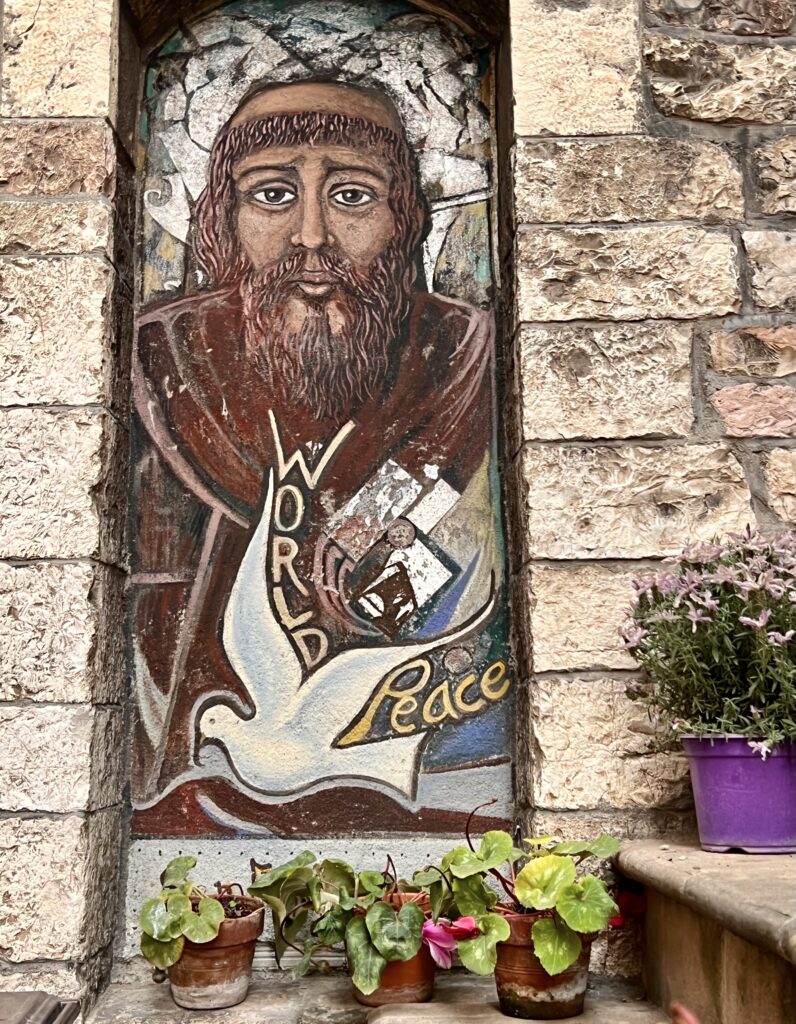
Tips For A One Day In Assisi Itinerary
Here are some must know tips for spending a day in Assisi.
1. How to Get To Assisi
Assisi is situated in the Umbria region of central Italy. It’s only 16 miles away from Perugia and 112 miles away from Rome, which makes it an easy 2 hour drive from either city. Florence is also just 2.5 hours away.
Travelers can easily access Assisi by train as well. The town’s train station is located at the base of the hill on which the town is perched. Shuttle buses run frequently between the station and the town center, making it easy to get around.
If you prefer to drive to Assisi, park your vehicle outside the town walls. The centro storico, or town center, is closed to all vehicles except for residents.
Fortunately, there are several well-marked parking lots located on the outskirts of town, such as the Port Nuova or Matteotti lots.
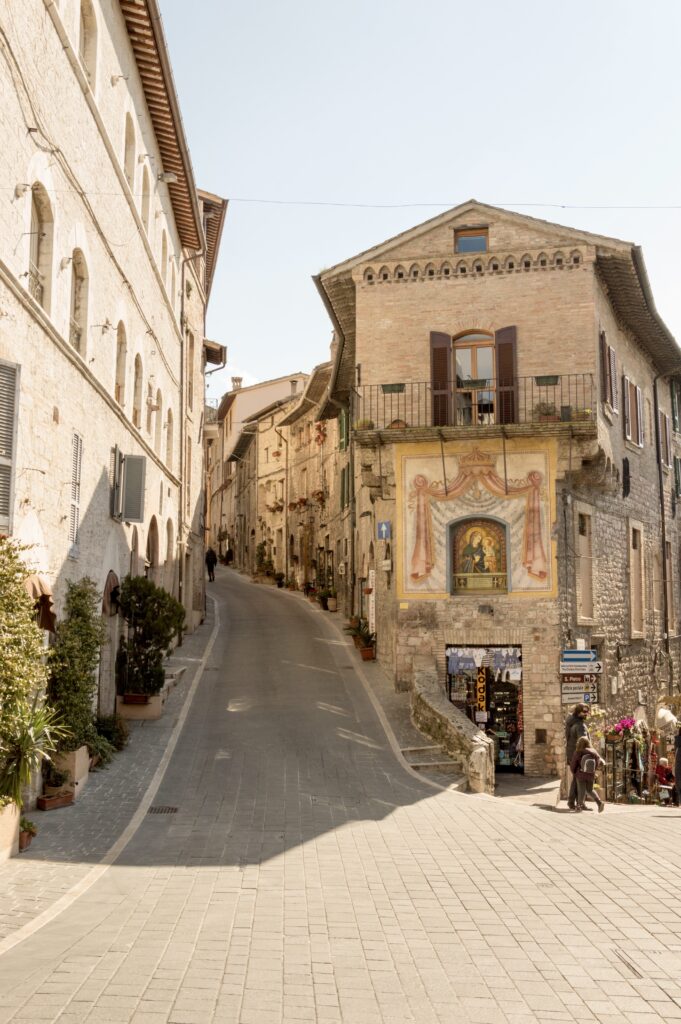
If you park in one of these lots, you’ll arrive at the east end of the town. Keep in mind that the town is approximately one mile long. The beautiful Basilica of St. Francis located at the westernmost end.
2. Guided Day Trips To Assisi
If you don’t want to deal with the hassle of transportation, there are plenty of options.
You can book a small group day trip tour from Rome or a private tour from Rome. You can also combine Assisi and Orvieto on a day trip from Rome.
You can also book a day tour to Assisi (+ Cortona) from Florence.
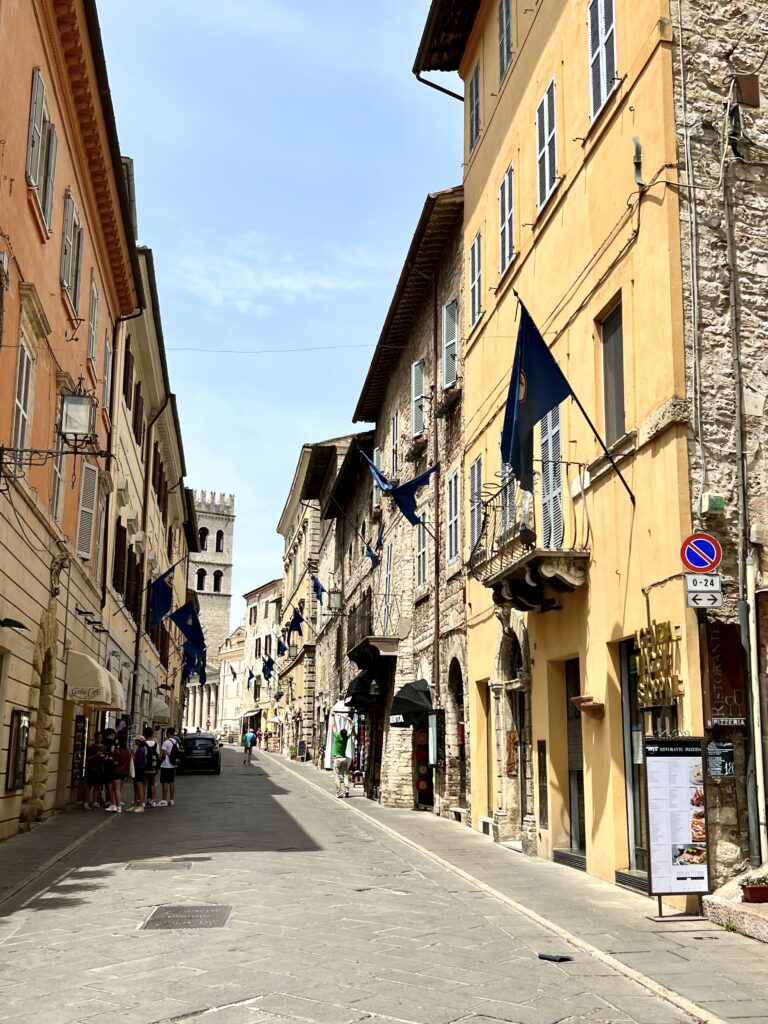
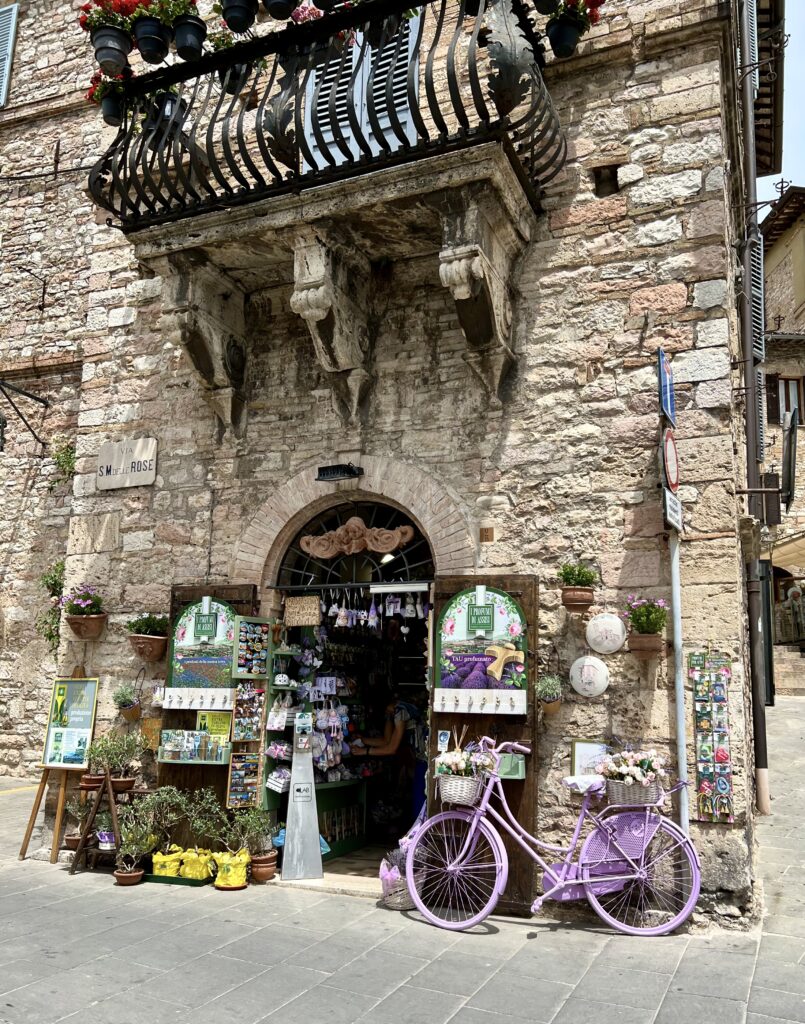
3. How To Get Around Assisi
Assisi is a town that can be traversed entirely on foot. However, be prepared for some challenging uphill walks. The town’s layout is predominantly vertical, making it feel like a test of endurance for pilgrims.
To make the most of your visit, consider booking a guided walking tour. The Basilica of St. Francis lacks proper signage, so a guide will help you identify the frescos.
Additionally, keep in mind that Via San Francesco, the main street of Assisi, is often congested with traffic. Cars can be seen speeding by all the time. On the other hand, the side streets are peaceful and dedicated solely to pedestrians.
I booked this 2.5 hour private Assisi tour, which was fantastic. The guide was a fount of knowledge about Assisi and its history. You can also book a 3 hour small group walking tour.
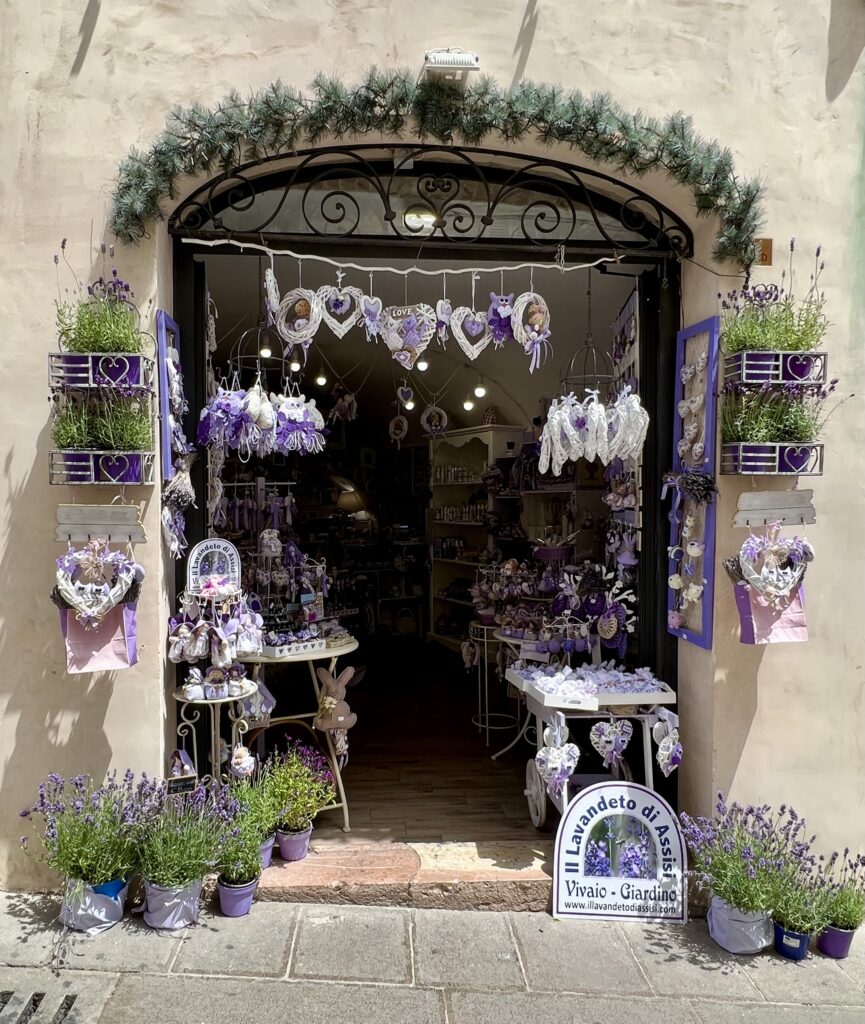
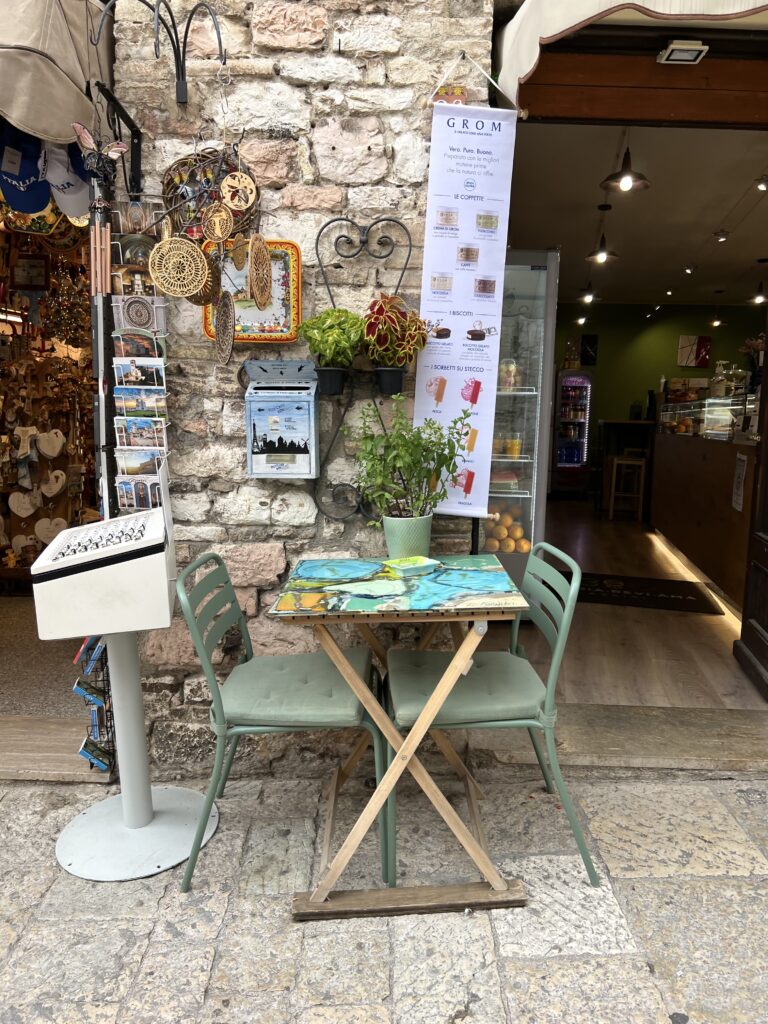
4. Where To Stay In Assisi
Spending a night in Assisi provides a unique opportunity to explore the town without the crowds of day trippers, who make up 85% of its visitors. Fortunately, Assisi has a variety of wonderful accommodation options to choose from.
The Nun Assisi Relais and Spa is a romantic luxury hotel housed in a former 13th century convent. The Dal Moro Gallery Hotel is a hip designer hotel with a rooftop garden.
Another option is the Giotto Hotel, a tradition historic hotel right near the Basilica of St. Francis.
If you want to stay outside Assisi in the Umbrian countryside, the Valle di Assisi Hotel & Spa is right outside Assisi and has a pool and terrace overlooking Assisi.
Borgo della Marmotta is about 20 miles from Assisi. It offers rustic-chic rooms and apartments in a restored 17th century hamlet, surrounded by vineyards, olive groves, and gardens.
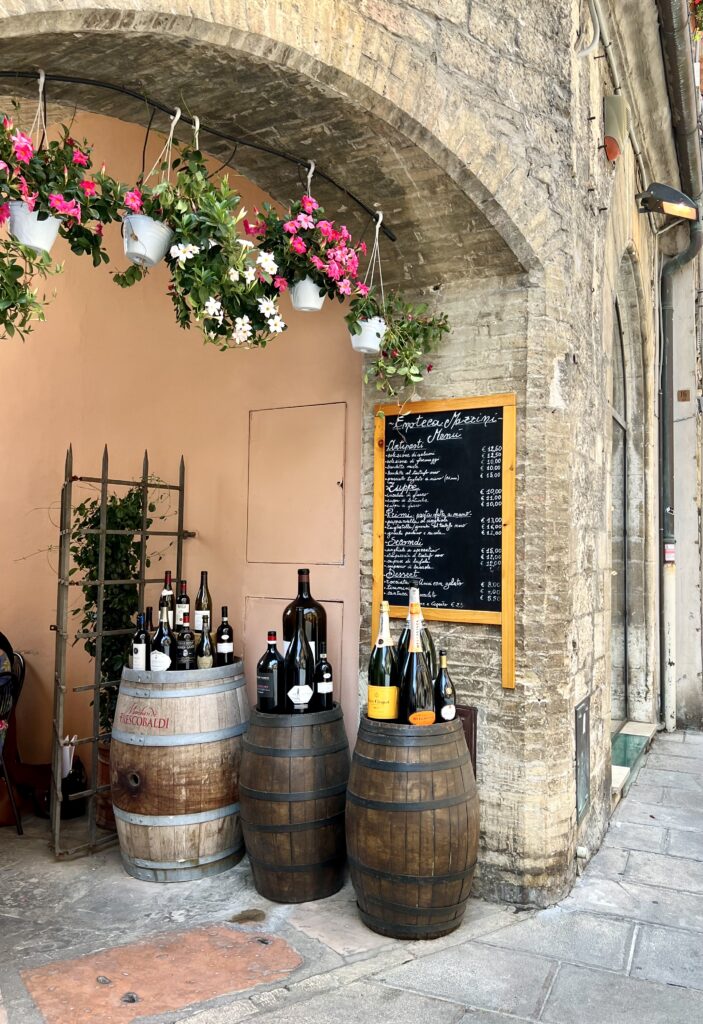
5. When To Visit Assisi
The best time to visit Assisi is in the spring or fall when the weather is mild and the crowds are smaller. The summer months can be hot and crowded, while the winter months can be cold and some attractions may be closed.
If you are interested in Assisi’s festivals, the Palio of San Rufino is held every August. It’s not a horse race like the Palio of Siena. Rather, it’s a crossbow competition among the three historic districts of Assisi.
You may also want to visit for the Feast of St. Francis. It’s an annual celebration to honor St. Francis. The celebration begins on the evening of October 3rd with a candlelit procession and ends with a solemn mass the next morning.
Another option is to plan your trip around the Infiorate di Spello. It’s a famous flower festival that takes place annually in late May or early June just a few miles away in Spello.
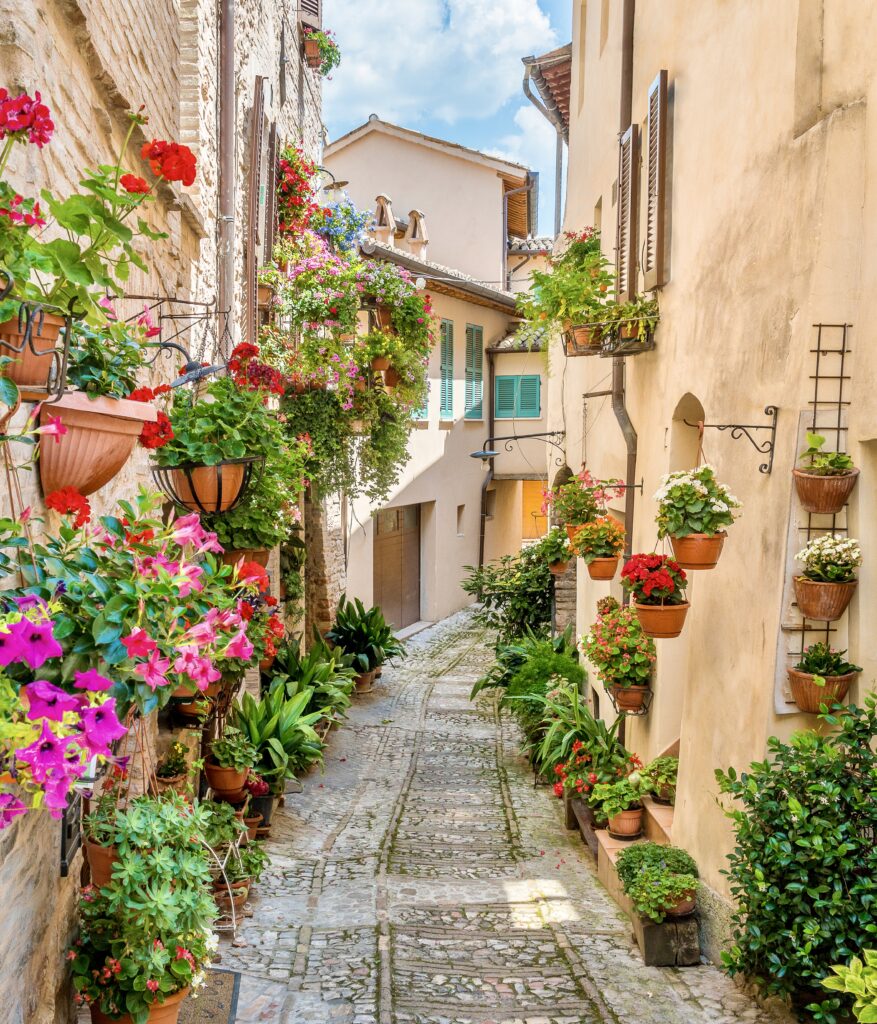
6. More Than One Day In Assisi?
If you have more than 1 day in Assisi, there are plenty of other things to do.
On the outskirts of Assisi, there are three other significant places you may want to visit: the church of St. Damian, the Sanctuary di Rivotorto, and the Carceri Hermitage.
The most convenient way to see all of these attractions is to drive to each of them. However, if you don’t have a car, you can still reach them by public transportation or taxis.
If you’d like to see more Roman ruins, you can visit the Villa of Mosaics, just 20 minutes away.
This remarkable villa is considered one of the most significant archaeological finds of the past two decades. The villa’s exquisitely preserved mosaics are among Italy’s finest, boasting intricate designs and vivid colors.
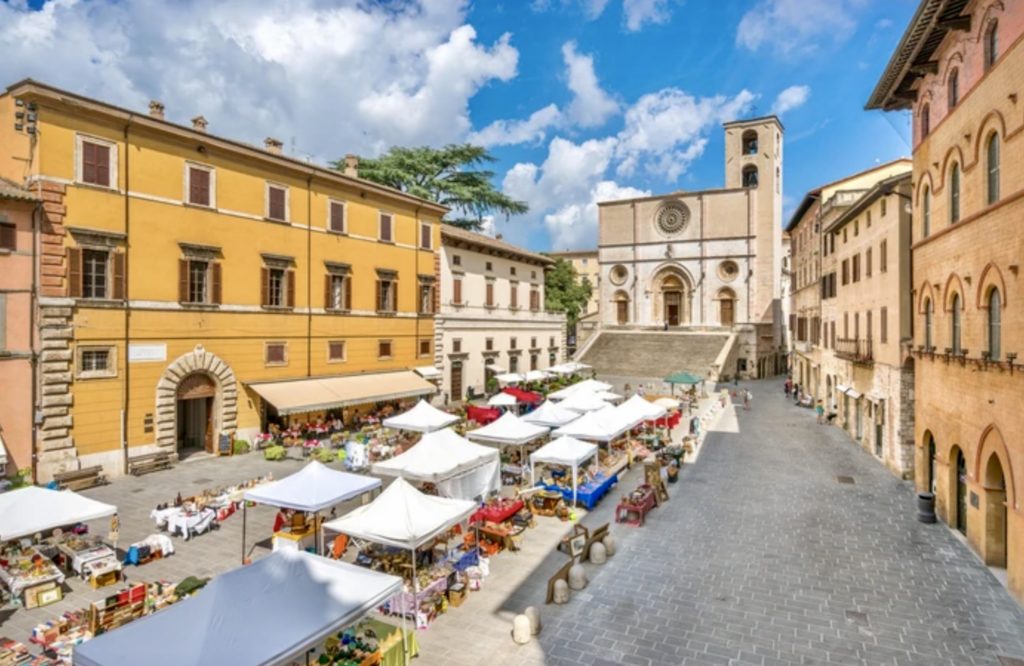
Today, the villa’s mosaics are displayed in a state-of-the-art museum featuring eight primary rooms to explore. Highlights include depictions of wild animals, mythological creatures, satyrs, and even a wine pouring scene.
You can also day trip to some other lovely medieval towns. I’ve written guides to Spello, Gubbio, Orvieto, and Civita di Bagnoregio that you can check out. For more ideas, you can also check out my 1 week itinerary for Umbria
I hope you’ve enjoyed my one day in Assisi itinerary. You may enjoy these other Italy travel guides and resources:
- 3 day itinerary for Rome
- 5 day itinerary for Rome
- 1 day itinerary for Vatican City
- 3 day itinerary for Florence
- 2 day itinerary for Venice
- 1 day itinerary for Milan
- 1 day itinerary for Siena
- Things To Do In San Gimignano
- 10 day itinerary for Tuscany
- 10 day itinerary for Italy’s classic cites
- 12 ways to spend 1 week in Italy
If you want to spend one day in Assisi, pin it for later.

